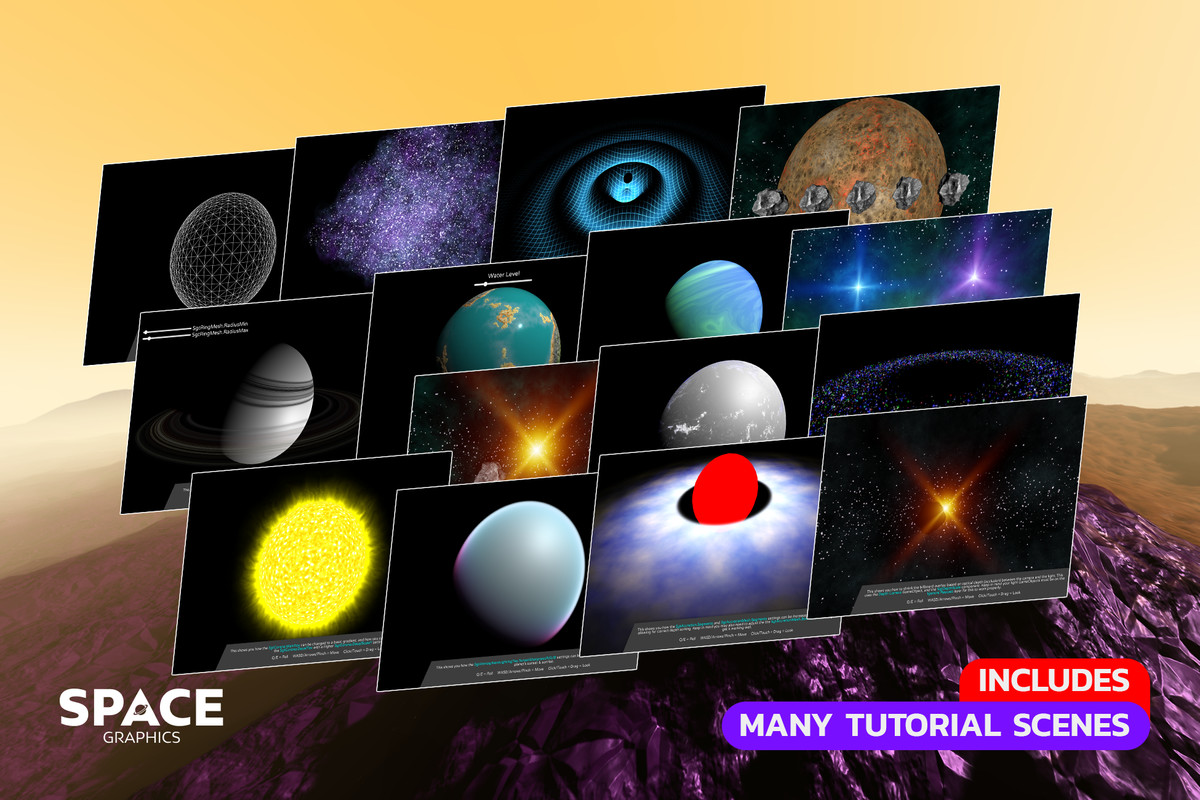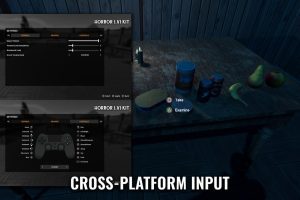Unity-Space Graphics Toolkit U3676

Make the space scene of your dreams using Space Graphics Toolkit. This huge collection of effects can be customized and combined in every way, allowing you to quickly make realistic or fantasy worlds.
Programmable Render Pipeline (SRP) compatibility
The Unity Programmable Render Pipeline (SRP) is a feature that allows you to control rendering through C# scripts. SRP is the underlying technology that supports the Universal Rendering Pipeline (URP) and the High Definition Rendering Pipeline (HDRP).
Unity version
Built-in rendering pipeline
Universal Rendering Pipeline (URP)
High Definition Rendering Pipeline (HDRP)
2021.3.0f1
compatible
compatible
compatible
2020.3.0f1
compatible
compatible
compatible
describe
Create the space scenes of your dreams with the Space Graphics Toolkit. This vast collection of spatial effects can be customized and combined any way you like, allowing you to quickly create worlds that are either realistic or fantastical.
🕹️ Demo 📄 Docs 💬 Forum 🌐 Site 📺 Videos
💡 Easy to use – Each feature has rich settings that you can adjust to get the exact visual effect you imagined. These settings provide documentation, step-by-step tutorial scenarios, and demo scenarios that combine multiple features.
💡 Long-term Support – Space Graphics Toolkit has been updated regularly for over 7 years and now has a large number of features. Thanks to everyone who has supported its development so far!
💡 All rendering pipelines – This asset supports standard pipelines, as well as LWRP, HDRP and URP. See the documentation to learn how to switch between them and for information about limitations.
💡 Full source code included – if you’re a programmer, feel free to adapt it to your hobby code, it can be easily modified.
💡 Advanced planet rendering – bring your planets to life with planet shaders. This allows you to dynamically control water levels, water animations, detail textures, night lighting, and more.
💡 Dynamic Planet Mesh LOD – If you need to create large planets and deliver high performance, your planet mesh must have a dynamic LOD that increases mesh detail based on camera distance. An easy-to-configure dynamic planetary system automatically solves this problem for you.
💡 Volumetric Atmosphere – Seamlessly enter and exit the atmosphere from space and fully demonstrate the scattering of sunlight in the atmosphere. This feature is highly optimized and every visual parameter is fully customizable.
💡 Seamless Planet Landing – Fly your spaceship from space all the way to the surface of a planet without any loading screens. MeshColliders are automatically generated as you approach the surface, so you can interact with any normal “rigid body” physics object.
💡 Powerful Planet Support – To generate such huge planets, heightmaps alone are not enough. When close enough, procedural terrain generation will take over and fill in the gaps.
💡 Planet Object Placement – Add variety to your planet’s surface using a procedural object placement system that uses splat maps to define which objects can spawn where. If you want to manually place the object on the surface, you can do that too.
💡 Newtonian Physics – Quickly add realistic gravity to your scene. This allows your players and spaceships to achieve realistic planetary orbits and landings, and even planets orbiting each other.
💡 Planetary Shadow System – Enhance scenes with high-performance dynamic shadows cast from planets and planetary rings. These are compatible with normal shadows and allow large objects to accurately block light in a scene.
💡 Volumetric Gas Giants – Experience realistic gas giants that allow you to seamlessly fly through them in space and beyond. These have been heavily optimized and even feature atmospheric scattering properties.
💡 Procedural Sky – Replace your skybox with thousands of highly optimized stars that take up almost no memory and display clearly even when zoomed in. The stars are procedurally placed and their distribution can be adjusted to easily achieve any visual effect.
💡 Debris Field – Fill the scene with procedurally generated asteroids and other debris. They can be made to spawn in specific areas, such as forming rings around planets, etc.
💡 Distortion and Dust Effects – Give the camera movement a sense of speed with a distortion effect that stretches stars as they fly across the lens. This can also be used to generate dust, giving the impression of traveling through a nebula as the camera passes over it.
💡 Asteroid Belt – Quickly create an asteroid belt with thousands of billboard rocks. These render incredibly fast and can be used to create realistic asteroid belt and accretion disk effects.
💡 Floating Origin System – Explore the entire universe with this easy-to-use yet powerful system that allows you to simulate a universe spanning over 50 billion light years! Combine procedural generation features to create a universe filled with fun to explore.
💡 Black Holes – Experience how these massive objects distort the light around them, and why light cannot escape the event horizon. There are two ways to achieve this effect, letting you choose between rendering speed and visual accuracy.
💡 Planetary Rings – Enhance your planet by adding planetary rings around it and reveal stunning views as light scatters through them. These planetary rings can also be used with planetary shadow systems, allowing them to cast huge shadows on your planets and gas giants.
💡 Animated Auroras – Create bizarre-looking planets by adding animated, fully customizable auroras around the planet’s poles. Configure their color and shape according to your actual needs.
💡 Accretion disks and astrophysical jets – simulates scenarios where material surrounding a black hole is sucked in and ejected out of the pole. The effect is heavily optimized and can be configured to get the look you need.
💡 Planetary Clouds – Add clouds above planets that can rotate and fade away as you approach.
💡 Solar Prominences and Flares – Bring your stellar effects to life with animated solar prominences and flares erupting from the surface.
💡 Spaceship Thrusters and Controls – Explore the stars with sample rocket ships, spaceship controls and thruster effects.
💡 Spiral and Elliptical Galaxies – Create massive galaxies with thousands of stars in seconds. These can be customized any way you like and are optimized to run on all devices.
💡 Nebula Generation – Quickly create nebulae based on source images and adjust settings to get the look you want.
💡 Volumetric Stellar Atmospheres — Use this feature to seamlessly fly from space, through a star’s atmosphere, and down to its surface.
💡 Optimized Stellar Flares – Quickly generate unique-looking stellar flares that can be customized any way you like, using almost no memory.
💡 Animated Star Surfaces – Star shaders allow you to customize the surfaces of stars.
💡 Animated Lightning — Bring your planet to life with fully customizable animated lightning storms.
💡 Gravitational Waves — Visualize the structure of space-time as black holes orbiting each other, or show how massive objects bend space around them.
💡 Realistic Visual Effects – Carefully adjust each setting to achieve realistic effects in seconds, perfect for space simulations.
💡 Fantasy Vision – Use your imagination to create anything you like, including fantasy worlds. Each visual setting contains a number of intuitive settings that you can adjust to create the look you like.
Thanks for reading ❤️
technical details
related keywords
space
Planet
atmosphere
volumetric
sun
gravity
universe
Galaxy
spaceship
VR
solar
Earth
Terrain
Asteroid
Sci-Fi




